Comprehensive Guide to 512GB SSDs for MacBook Air
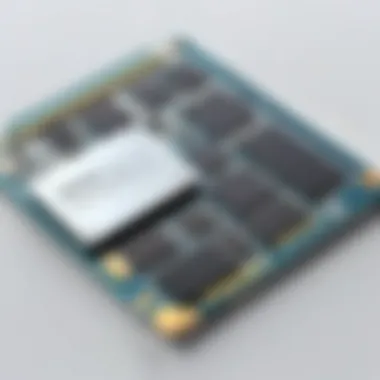
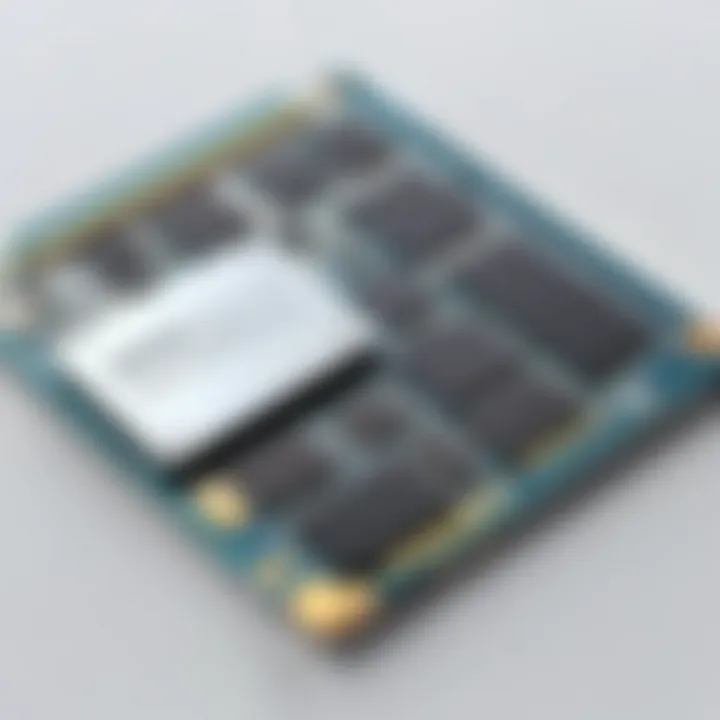
Intro
As technology evolves, the demand for efficient storage solutions increases. The MacBook Air, known for its lightness and portability, often faces limitations concerning storage capacity. Many people find that a 512GB SSD is a sweet spot, providing ample space for applications, files, and media without overwhelming the system. This article will effectively examine different 512GB SSD options catered specifically for MacBook Air users.
By understanding what is available in the market today, you will be in a better position to make educated decisions. From evaluating technical specifications to looking into installation processes, every aspect will be explored in detail. Whether you are a tech enthusiast, a DIY builder, or someone simply looking to optimize their MacBook Air, this guide aims to deliver all necessary insights.
Get ready to deepen your understanding of SSD storage technologies tailored for your device.
Product Overview
Brief Description
512GB SSDs are essential upgrades for many MacBook Air users. They can significantly improve system performance and storage capabilities. These drives utilize flash memory, creating faster read and write speeds compared to traditional hard drives. With a 512GB option, users can store everything from software applications to large multimedia files.
Key Features
- High Speed: Enhanced data transfer rates significantly reduce boot times and file access.
- Durability: SSDs have no moving parts, making them more durable compared to HDDs, which often are prone to mechanical failure.
- Energy Efficiency: Consumes less power than traditional drives, resulting in longer battery life for the MacBook Air.
- Compact Design: Space-saving feature allowing it to fit where traditional drives might be cumbersome.
Available Variants
While several manufacturers produce SSDs for MacBook Air, the most notable products include:
- Samsung 970 EVO Plus: Known for excellent performance and reliability.
- Crucial P3: A well-rounded option with solid specifications at a competitive price.
- OWC Aura Pro X2: A specialized SSD designed specifically for Mac computers, offering seamless compatibility.
Specifications Breakdown
Technical Specifications
Selecting a 512GB SSD means understanding its specifications, such as interface, sequential read/write speeds, and form factor. Most models feature NVMe interfaces, providing faster access speeds compared to SATA connections. Typical read speeds range from 3000 to 3500 MB/s, while write speeds often closely follow.
Performance Metrics
Performance metrics are a crucial determinant when choosing an SSD. For instance, the random read and write speeds play significant roles in everyday usage. A good SSD will excel in multitasking operations, making it ideal for programming, gaming, or heavy software usage.
Compatibility Information
Compatibility is vital. Ensure that the SSD is compatible with your specific MacBook Air model, as not every SSD can be installed in every version. Research and confirm if your version supports NVMe drives, as older versions may only accommodate SATA SSDs.
Comparative Analysis
Competing Products
When considering SSD options, a few critical players dominate the market. Each of these brands offers strengths and weaknesses. Comparing products will help you assess which SSD aligns best with your needs.
Strengths and Weaknesses
- Samsung 970 EVO Plus: High performance, but can be more expensive than competitors.
- Crucial P3: Affordable with decent performance, but may not match top-tier SSDs in speed.
- OWC Aura Pro X2: Tailored for Macs with optimized performance, often priced higher than standard SSDs.
Price Comparison
Price can vary widely between SSD models. Paying more typically translates to better performance, but it’s essential to weigh your use case against your budget. A typical range for 512GB SSDs starts around $80 and can go up to $300 based on performance and brand reputation.
Buying Guide
Target User Profiles
Knowing your requirements is essential. For example, gamers might prioritize speed, while light users might focus on affordability and reliability.
Important Considerations
- Form Factor: Make sure to match the drive form factor with your MacBook Air model.
- Read/Write Speeds: Higher speeds generally translate to better overall performance.
- Warranty: Check manufacturer warranties for reassurance on the longevity of your investment.
Insider Tips for Buyers
- Research Compatibility: Always double-check that the SSD is compatible with your MacBook Air model.
- Watch for Deals: Prices fluctuate, so be on the lookout for promotions.
Maintenance and Upgrade Insights
Regular Maintenance Practices
Regularly updating firmware and keeping the drive free of unnecessary files can extend its lifespan and performance.
Upgrade Paths and Options
If you feel limited by your current SSD capacity, assess your needs. Opt for a 1TB SSD if you often work with large files or applications.
Troubleshooting Common Issues
Should performance degrade or if you encounter access issues, often a simple restart or checking connections can resolve them. If persistent, consider running diagnostics to identify underlying issues.
Remember, proper management and timely upgrades can significantly enhance your MacBook Air's functionality.
Foreword to SSDs
In the realm of computer storage, Solid State Drives (SSDs) have significantly changed how data is managed and accessed. Understanding SSDs is crucial for anyone looking to enhance the performance of their MacBook Air. This article explores the relevance of SSDs, particularly the 512GB options available, emphasizing the benefits and considerations that come with these upgrades.
What is an SSD?
An SSD, or Solid State Drive, is a storage device that uses flash memory to store data. Unlike traditional Hard Disk Drives (HDDs), SSDs do not have moving parts. This lack of mechanical components allows SSDs to access data nearly instantly, providing faster load times and improved overall system responsiveness. The architecture of SSDs generally includes various types of NAND flash memory, controller chips that manage data flow, and interfaces such as SATA or PCIe for connecting to the computer.
In the context of a MacBook Air, this means that upgrading to an SSD can noticeably speed up boot times, application launches, and file transfers. It is essential to highlight that SSDs have become increasingly popular due to their performance and reliability, but the choice of a compatible SSD is crucial to maximizing these advantages.
Benefits of Using SSDs
The transition from HDDs to SSDs offers multiple benefits, particularly for users of MacBook Air who require efficiency and speed. Some key advantages include:
- Speed: SSDs provide significantly faster read and write speeds compared to HDDs, often resulting in performance gains of several times.
- Durability: Since SSDs do not have moving parts, they are less prone to mechanical failure. This quality makes them more reliable over time, which is essential for those who rely on their devices for work or gaming.
- Lower Power Consumption: SSDs consume less power, which positively impacts battery life. This aspect is particularly significant for laptops like the MacBook Air, where battery efficiency is crucial.
- Noise Reduction: The absence of moving components means SSDs operate silently, enhancing the user experience.
- Form Factor: SSDs come in various form factors that can be more compact than traditional HDDs. This feature can provide additional flexibility in device design and functionality.
In summary, SSDs represent a pivotal advancement in data storage technologies. For MacBook Air users considering an upgrade to a 512GB SSD, the potential for improved performance and user experience is substantial in today’s digital landscape. By understanding SSDs, users can make informed decisions that enhance their overall computing experience.
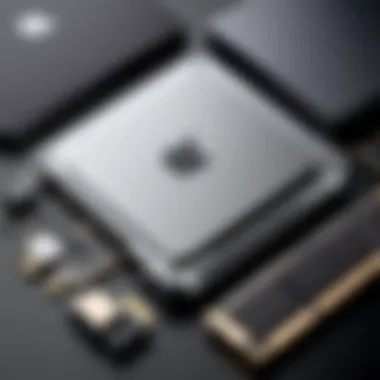
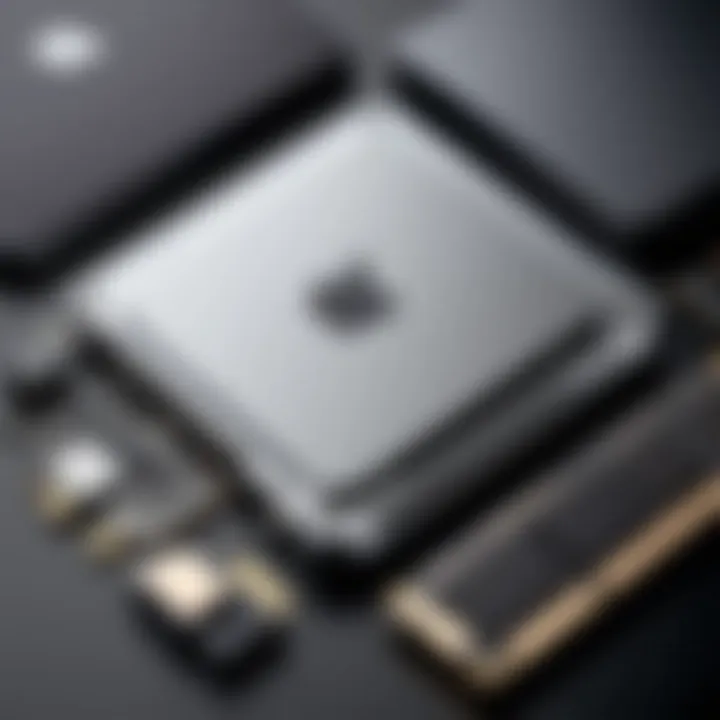
Understanding MacBook Air Storage
Understanding the storage options available for MacBook Air is crucial for anyone considering an upgrade. This section will delve into the various aspects of storage, including types available and their impact on daily usage. An informed choice can significantly enhance the overall user experience.
Overview of MacBook Air Storage Options
MacBook Air utilizes several storage technologies. The options vary depending on the model and year of production. Generally, the storage choices include SSD and flash storage.
- SSD: Solid State Drives provide faster data access and improved performance compared to traditional hard drives. They are less prone to mechanical failure due to the absence of moving parts.
- Flash Storage: Apple's proprietary flash storage is integrated directly into the device. While this storage type can offer excellent performance, it often limits the user's ability to upgrade later.
For those looking to enhance their MacBook Air, understanding whether your model supports upgrades is key. Knowing the specifications can help users make better decisions based on their storage needs.
Standard Storage Capacities
The storage capacities for MacBook Air models have evolved over time. Most recent versions typically offer the following:
- 128GB: This is often the base option for entry-level models. It may be sufficient for light users, such as those who primarily use web applications.
- 256GB: A more common choice for average users, providing enough space for applications, documents, photos, and some media files.
- 512GB: Tailored for power users, professionals, and gamers who require more robust storage options to handle larger files or applications.
- 1TB and Above: These options usually cater to users with extensive storage requirements, such as content creators or those using resource-intensive software.
In summary, the choice of storage capacity significantly affects MacBook Air's functionality. Users should assess how much storage they need before upgrading or purchasing a new device. Ensuring that your model supports these capacities is critical for an effective upgrade.
The Case for 512GB SSD Upgrades
Upgrading to a 512GB SSD for a MacBook Air is not just a superficial enhancement; it addresses fundamental needs for both everyday users and tech enthusiasts alike. The transition from traditional hard disk drives (HDDs) to SSDs represents a significant leap in technology, impacting storage speed, device responsiveness and overall system performance. Specifically, the 512GB capacity serves as a versatile middle ground for various types of users, ranging from casual consumers to professionals requiring ample space for applications and files.
Assessing Storage Needs
Determining whether a 512GB SSD is appropriate involves understanding individual storage requirements. Many users today manage large files including high-definition videos, extensive photo libraries, and demanding software applications. For those who fall into this category, evaluating the existing storage consumption becomes imperative.
- Examine Current Usage: Begin with a review of current file sizes and the applications in use. Free monitoring tools can provide insights into what occupies the most space.
- Future Consideration: It is also wise to estimate potential future needs. Will you be engaging more in content creation, gaming, or extensive software development? If so, you may want to plan ahead.
- Operating System and Applications: Remember that macOS and its associated applications typically require a decent amount of memory. A 512GB SSD can be incredibly beneficial as macOS tends to grow in size with updates.
Considering these factors ensures that the SSD upgrade is not an excess but a tailored solution for storage needs.
Impact on Performance
The switch to a 512GB SSD has far-reaching implications on overall device performance. Speed is the most immediate advantage users will experience. The following points outline how an SSD can improve the performance metrics of a MacBook Air:
- Boot Time: SSDs drastically reduce boot times. Users may notice their machine starts up within seconds instead of the minutes typical of HDD systems.
- Read and Write Speeds: The read and write speeds of SSDs can be several times faster than traditional drives. This translates to quicker file access and significantly improved application load times.
- System Responsiveness: Everyday tasks such as multitasking, opening documents, and switching between applications become smoother and faster. This improvement is particularly noticeable when running large or multiple applications simultaneously.
- Durability: Since SSDs have no moving parts, they are more resistant to shock and damage, enhancing the reliability of crucial data storage.
By upgrading to a 512GB SSD, users maximize their investment in the MacBook Air, leading to an experience that enhances productivity and satisfaction.
In summary, the case for a 512GB SSD upgrade is compelling. It is essential for evaluating current and future storage needs and recognizing the substantial impact that performance has on user experience.
Identifying Compatible SSDs for MacBook Air
Understanding the compatibility of SSDs for the MacBook Air is crucial for anyone considering an upgrade. Selecting the right SSD not only influences performance but can also impact the overall functionality of the device. A wrong choice can lead to inefficiencies, unnecessary costs, and in some cases, an unusable laptop. Therefore, knowing the specifications and compatibility factors becomes imperative.
Key Compatibility Factors
When evaluating SSDs for the MacBook Air, several compatibility factors should be taken into account:
- Form Factor: The SSD must fit the physical space designated in the MacBook Air. Most models utilize an M.2 form factor.
- Interface Type: It is essential to match the interface type of the SSD with the MacBook’s interface. NVMe interfaces provide faster speeds than SATA, therefore, choosing an NVMe SSD can boost performance significantly.
- Firmware Compatibility: Not all SSDs may have the required firmware to work with specific versions of macOS. Ensuring that the SSD is compatible with your MacBook Air model and its Operating System is vital.
- Heat Management: Some SSDs may run hotter than others. Since Apple's design is often compact, ensuring proper heat management in the SSD can prevent thermal throttling.
It’s advisable to refer to technical specifications thoroughly before making a purchase.
Connection Interfaces Explained
MacBook Airs utilize specific connection interfaces for SSD upgrades. Understanding these interfaces simplifies the selection process.
- PCIe (Peripheral Component Interconnect Express): This is the most common connection type for newer MacBook Air models. It offers a high-speed connection, making it the preferred choice for performance-oriented users.
- SATA (Serial ATA): While still used, SATA connections are slower compared to PCIe. SSDs using SATA are typically found in older MacBook Air models.
- Thunderbolt: Some external SSDs may connect via Thunderbolt, facilitating high-speed data transfer. However, external solutions won't replace the internal SSD but instead complement storage needs.
In summary, ensuring that the SSD's specifications align with the MacBook Air's requirements maximizes efficiency and longevity. Knowledge of these compatibility factors helps in making informed decisions, ultimately enhancing the overall user experience.
Recommended 512GB SSD Models
Choosing the right SSD for your MacBook Air is a critical decision. The performance, reliability, and durability of these storage options can greatly affect your workflow. Several brands offer 512GB SSDs specifically compatible with MacBook Air models. Understanding the features and specifications of these options helps users make informed choices. With storage upgrades, you can enhance your laptop’s responsiveness and overall performance. It is important to consider aspects such as read-write speeds, warranty, and customer support when evaluating these SSDs.
Brand A: Features and Specifications
Brand A has garnered attention for its strong performance and reliable technology. This model often features:
- Read Speed: Up to 3400 MB/s
- Write Speed: Up to 3000 MB/s
- Interface: NVMe PCIe 3.0
- Form Factor: M.2 2280
- Endurance: 400 TBW (Terabytes Written)
The endurance rating indicates a good lifespan for the drive, making it suitable for both casual users and heavy workloads. Additionally, this brand frequently offers firmware updates, ensuring long-term performance maintenance.
Brand B: Features and Specifications
Brand B stands out for its innovative technology and excellent user feedback. Key specifications include:
- Read Speed: Up to 3500 MB/s
- Write Speed: Up to 3000 MB/s
- Interface: NVMe PCIe Gen 3
- Form Factor: M.2 2280
- Endurance: 500 TBW
With one of the highest endurance ratings in the market, this SSD supports extensive data transfers while maintaining speed efficiency. The reliable thermal management of Brand B also contributes positively to its performance during extended use.
Brand C: Features and Specifications
Brand C is reputed for offering a balance of performance and price. This model is known for:
- Read Speed: Up to 3200 MB/s
- Write Speed: Up to 2900 MB/s
- Interface: NVMe PCIe 3.0
- Form Factor: M.2 2280
- Endurance: 300 TBW
Although this SSD has a slightly lower endurance compared to others, it presents a compelling choice for users prioritizing affordability without sacrificing too much on speed. Its compact design enables seamless installation in MacBook Airs, which adds to its appeal.
Choosing the right model depends on what you value most: speed, endurance, or price.
Understanding these specifications enables users to select the SSD that best meets their needs and aligns with their usage requirements.
Installation Process for SSDs
The installation process for SSDs is an essential topic in this article, as it directly impacts the performance and longevity of your MacBook Air. Understanding how to properly install an SSD can result in enhanced storage capability and improved system response. It is not just a matter of removing the old drive and replacing it; the process involves specific steps and careful handling of sensitive components. Thus, getting the installation right is crucial.
Tools Needed for Installation
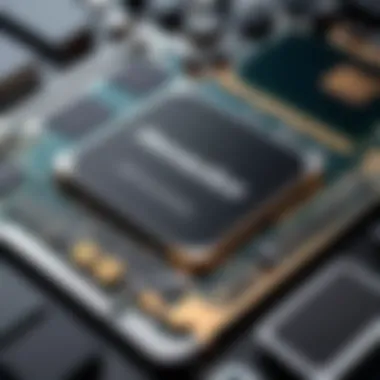
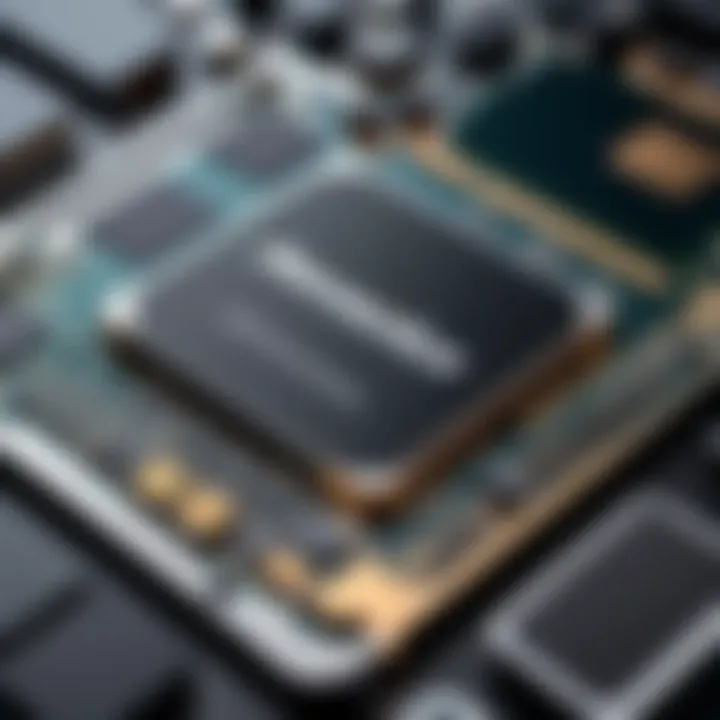
Before starting the installation, having the right tools is vital. The tools required include:
- P5 Pentalobe screwdriver: This is necessary for removing the bottom case of the MacBook Air.
- T5 Torx screwdriver: This tool is used to replace the SSD itself inside the device.
- Plastic spudger: Helps in opening the case without scratching it.
- Anti-static wrist strap: To prevent static charge from damaging sensitive components.
- Clean workspace: It's best to work in a clean environment to avoid dust entering your device.
Having these items on hand ensures a smoother installation process and reduces the risk of damaging your MacBook Air.
Step-by-Step Installation Guide
Installing an SSD in your MacBook Air requires care and attention. Follow these steps:
- Backup Your Data: Begin by backing up your important files. Migration tools can assist you in this process.
- Shut Down Your MacBook: Ensure the device is completely powered off.
- Remove the Bottom Case: Use the P5 Pentalobe screwdriver to remove the screws. Gently lift off the bottom panel with a spudger.
- Ground Yourself: Before touching any internal components, wear an anti-static wrist strap. This helps prevent damage from static electricity.
- Locate the SSD: Identify the SSD module inside the MacBook. It is usually situated near the logic board.
- Unscrew the Existing SSD: With the T5 Torx screwdriver, remove the screw holding the old SSD in place, then slide it out gently from its slot.
- Insert the New SSD: Align the new 512GB SSD with the connector and slide it in. Ensure it is securely in place and then screw it tightly.
- Reattach the Bottom Case: Place the bottom case back and secure it with the screws you previously removed.
- Power On: Turn on your MacBook Air. You should now see the new storage available for use.
- Restore Data: If you backed up your files, you can now restore them using the migration tools.
Following these steps will not only ensure a successful installation but also enhance your overall experience with your device.
Completing the installation process correctly ensures that the SSD works optimally and prolongs the life of your MacBook Air.
Data Migration Strategies
Data migration is a critical process when upgrading to a new SSD, particularly for MacBook Air users. It involves transferring existing data from the old storage drive to the new SSD. Careful planning can minimize data loss and downtime, making it an essential step in any upgrade.
Preparing Your Data for Transfer
Before starting the migration, organizing your data is key. Here are some steps to consider:
- Backup Your Data: Always start by backing up your important files. Use tools like Time Machine or an external drive. This ensures you have a copy of your data in case something goes wrong.
- Clean Up Unnecessary Files: Take this opportunity to declutter. Remove files you no longer need. This will make the transfer faster and the new SSD less cluttered.
- Organize Files: Group similar files together. This can simplify the process later when you are ready to organize them on your new SSD.
- Check for Compatibility: Ensure that the data you are migrating is compatible with macOS running on MacBook Air. Some older software may cause issues after migration.
Preparing your data properly can significantly ease the transition to your new SSD. It reduces the risk of errors during the migration process.
Using Migration Tools
Several tools facilitate the data migration process, which can simplify your upgrade experience.
- macOS Migration Assistant: This built-in tool allows users to transfer files, applications, and settings from your old drive directly to the new SSD. It’s straightforward, user-friendly, and optimal for users not wanting to deal with complex external applications.
- Cloning Software: Programs such as Carbon Copy Cloner or SuperDuper! can create a complete copy of your old drive, maintaining your original system's state. This option is useful for users who want a more thorough migration, ensuring all settings, applications, and files maintain their original structure.
- Third-Party Applications: There are various applications available that can further streamline the process. For example, Stellar Data Recovery can assist in recovering any lost data if an issue arises during migration. Other utilities include Clonezilla for more advanced users.
Using the right tools can make the migration process smoother and more efficient. Each tool offers unique features that cater to different user needs and technical abilities.
Performance Benchmarks of 512GB SSDs
Performance benchmarks are crucial when choosing a 512GB SSD for your MacBook Air. These metrics demonstrate how each SSD performs under various situations. Understanding these benchmarks helps you make an informed decision based on your specific needs. It is not just about storage; it is about how fast and efficiently your SSD can handle data.
Read and Write Speeds Compared
Read and write speeds are among the most important benchmarks to evaluate. They determine how quickly data can be accessed or saved. For a 512GB SSD, the read speed typically measures how fast the drive can retrieve files, while the write speed measures how quickly files can be saved to the drive.
- SATA SSDs: Often have lower speeds, averaging around 500 MB/s for both read and write.
- NVMe SSDs: Provide significantly higher speeds, often reaching up to 3500 MB/s for reading and around 3000 MB/s for writing.
Choosing an NVMe SSD can greatly enhance your experience, especially in tasks such as gaming, video editing, or large file transfers. For most users, SATA SSDs offer sufficient speed. However, if your needs include heavy multitasking or processing, investing in a faster NVMe SSD will be worthwhile.
Real-World Application Tests
Real-world application tests offer a glimpse into how the SSD performs under everyday conditions. This can include loading applications, booting up the operating system, or transferring files between devices.
For instance, in tests conducted on various 512GB SSD models:
- Boot Times: NVMe drives tend to boot macOS in around 10 seconds, while SATA SSDs may require 15 to 20 seconds.
- Application Launch Times: Applications such as Photoshop or Final Cut Pro may launch in as little as 2 seconds on a NVMe drive, compared to approximately 5 seconds on a SATA drive.
- File Transfer: Copying a large file, like a 10GB video, could take 30 seconds on NVMe but may exceed a minute on SATA.
These tests reflect how the specifications translate into everyday use. While synthetic benchmarks provide raw data, real-world performance affects user experience significantly.
A high-performance SSD offers improved responsiveness and can handle multiple tasks without noticeable lag.
Understanding these elements allows you to select the right SSD tailored to your specific needs and usage.
Common Issues and Troubleshooting
Troubleshooting is an essential part of maintaining SSD performance. As users upgrade to a 512GB SSD, they may face challenges that hinder optimal operation. Being aware of common issues helps in identifying problems early. This understanding contributes to a smoother user experience, making it easier to address concerns before they escalate.
Recognizing Common Problems
Users may encounter several typical issues with SSDs in their MacBook Air. Here are some notable examples:
- Slow Performance: This can arise from fragmentation and filled storage. Regular maintenance is necessary.
- Drive Not Detected: Often caused by connection issues or improper installation, leading to frustrating user experience.
- Read/Write Errors: Can be due to faulty hardware or software conflicts. Recognizing this early helps to prevent data loss.
- Overheating: Excessive heat may indicate hardware failure, risking the integrity of the data.
Each of these problems can significantly impact usability. Users should remain vigilant and periodically monitor the performance of their drives.
Solutions to SSD Issues
Addressing SSD problems involves a combination of preventative measures and corrective actions. Effective strategies include:
- Regular Firmware Updates: Keeping firmware up to date ensures optimal compatibility and performance.
- Using Disk Utility: This builtin Mac tool can help repair the disk and manage partitions, should issues arise.
- Optimizing Storage: Utilize tools like CleanMyMac to clear up unnecessary files that can slow down the SSD.
- Proper Installation Practices: Always ensure that the SSD is properly seated and connections are secure during installation.
It's important for users to have a basic understanding of their hardware, as many issues stem from installation errors or lack of maintenance.
Approaching problems with a structured method minimizes potential downtime. By recognizing issues early and employing sound solutions, users can maintain their MacBook Air's efficiency with a 512GB SSD.
Maintaining Your SSD
Maintaining your SSD is essential for optimizing its performance and longevity. While Solid State Drives are inherently more reliable than traditional hard drives, they still require proper care and management to function at their best. A well-maintained SSD can prevent data loss, ensure quicker access times, and prolong the overall lifespan of the storage unit. By understanding the essential elements of SSD maintenance, users can effectively enhance their MacBook Air's performance and reliability.
Best Practices for Longevity
To maximize the longevity of your SSD, consider implementing the following best practices:
- Keep the SSD Firmware Updated: Regularly check for firmware updates from the manufacturer. Updated firmware can improve performance and fix bugs.
- Avoid Filling the SSD to Capacity: Keep at least 10-20% of the SSD free. This can improve write performance and extend the drive's lifespan.
- Limit Write Cycles: SSDs have a limited number of write cycles. When possible, avoid unnecessary writes, such as creating and deleting large files frequently.
- Enable TRIM: Ensure that TRIM is enabled on your MacBook Air. This helps optimize the SSD by allowing the operating system to inform the drive which blocks of data are no longer in use.
- Use Sleep Mode: Let the SSD enter sleep mode when not in use. This reduces wear and tear on the drive by minimizing changes in data states.
Monitoring SSD Health
Monitoring the health of your SSD is critical for ensuring optimal performance. Keeping an eye on specific metrics can alert you to potential problems before they become serious. Here are key aspects to monitor:
- SMART Status: Self-Monitoring, Analysis, and Reporting Technology (SMART) provides insights into the health of your SSD. Regularly check the SMART status using disk utility tools.
- Read and Write Speeds: Keep track of the SSD's read and write speeds. If you notice a significant drop, it could indicate underlying issues.
- Temperature Levels: Excessive heat can damage SSD components. Use monitoring software to ensure the operating temperature remains within safe limits.
- Error Rates: Pay attention to error rates. High levels of errors may indicate impending failure and should be addressed promptly.
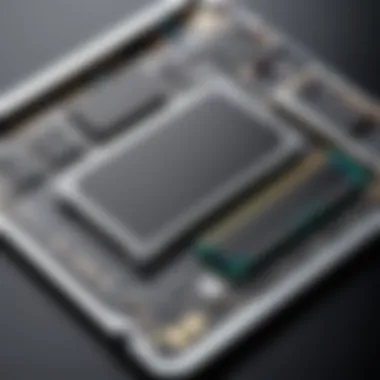
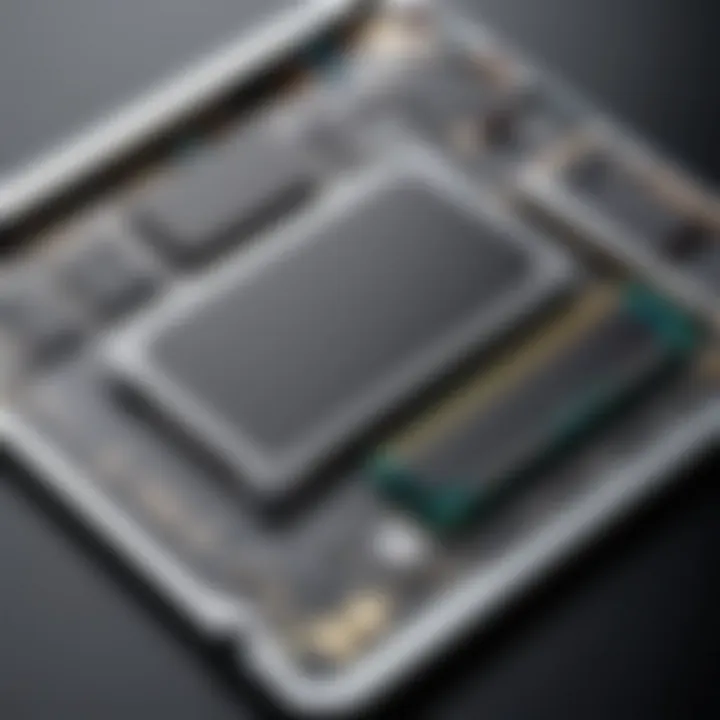
Maintaining your SSD involves understanding its components and monitoring its performance. By following best practices and keeping an eye on health metrics, users can ensure their SSD remains reliable and efficient.
Cost Considerations
When contemplating an upgrade to a 512GB SSD for your MacBook Air, cost considerations hold significant weight. It is not just about the initial purchase price of the SSD; a thorough evaluation of total costs associated with the upgrade is essential. This section dives into aspects such as budgeting for the upgrade, understanding the differences between various price points, and evaluating the relation between price and performance.
Budgeting for Your Upgrade
Creating a realistic budget is the first step in upgrading your MacBook Air's storage. Multiple factors influence the pricing of SSDs.
- Type of SSD: Whether you opt for NVMe or SATA affects the budget. NVMe drives often provide superior speed but come at a higher price compared to SATA alternatives.
- Brand and Reliability: Well-known brands like Samsung and Crucial may charge more due to their reputation for reliability and performance. Cheaper options might exist, but ensure you check for quality ratings.
- Warranty and Support: Investing in brands that offer solid warranty terms can safeguard against potential future problems. A longer warranty may justify a higher price.
Budgeting for your upgrade needs careful thought. Due to varying prices, it’s advisable to research reviews and user feedback. Allocate extra funds if necessary to ensure you are getting a quality product.
Value vs.
Performance
The relationship between cost, value, and performance is critical when selecting your SSD. Not all high-priced SSDs guarantee superior performance.
- Performance Metrics: Focus on essential specifications, such as read and write speeds, durability, and endurance ratings. These factors will often correlate with overall performance.
- User Needs: Assess what you truly need from your SSD. A gamer might require rapid load times, while a casual user may prioritize storage capacity over speed.
- Cost-Effectiveness: Weigh the performance improvements against the additional costs. Spending a bit more might be worthwhile if it significantly enhances performance and longevity.
"Understanding the balance between performance and cost can save both money and frustration in the long run."
Warranty and Support
The warranty and support aspects of a 512GB SSD are often overlooked by users when upgrading their MacBook Air. This oversight can lead to frustration if issues arise after the purchase. Understanding the warranty and support options available can make a significant difference in the overall experience of using your new SSD.
Understanding Warranty Terms
When considering an upgrade to a 512GB SSD, it is crucial to comprehend the warranty terms provided by the manufacturer. A warranty typically covers defects in materials and workmanship. Here are some critical points to keep in mind:
- Duration: Warranties can vary in length. Most 512GB SSDs come with a warranty ranging from three years to five years. Longer warranties often indicate a level of confidence from the manufacturer about the durability of the product.
- Coverage: Some warranties cover only the SSD itself, while others may offer additional coverage for data recovery in case of failure. Understanding this distinction is essential for protecting your investment.
- Conditions: Warranties often have specific conditions. For instance, proper installation is usually required to maintain warranty validity. If a user fails to install the SSD correctly, the warranty may become void. It is wise to read the warranty terms thoroughly before proceeding with the upgrade.
Understanding these terms can help users choose a product that not only meets their storage needs but also provides peace of mind regarding future performance.
Accessing Customer Support
Having access to reliable customer support is another vital factor when choosing a 512GB SSD. Manufacturers differ in the support services they offer. Here’s what to consider:
- Availability: Check if the customer support is accessible during working hours, and whether it includes weekends. Some brands offer 24/7 support, while others may have limited hours.
- Channels: It's essential to know how to reach customer support. Many companies provide support through various channels such as phone, email, or online chat. Having multiple options can be helpful if immediate assistance is needed.
- Expertise: Customer support should have knowledgeable representatives who can assist with installation, compatibility issues, or troubleshooting inquiries. Reviews and testimonials often shed light on the effectiveness of a company's support.
- Documentation: Look for user manuals, FAQs, and other documentation that the manufacturer offers on their website. Comprehensive resources can often solve problems without needing to contact support.
Remember: Quality customer support can be a lifesaver during unexpected situations, ensuring that you can keep your MacBook Air running smoothly with your new SSD.
Comparative Analysis of 512GB SSDs
A comparative analysis of 512GB SSDs is essential for tech enthusiasts and DIY builders looking to upgrade their MacBook Air. With various options available, understanding them helps consumers make informed choices that align with their specific needs. Factors such as brand reputation, warranty policies, price, compatibility, and performance metrics come into play during this decision-making process.
Vendor Comparison
Vendor selection affects the overall quality and reliability of the SSD chosen. Each brand has its unique strengths and weaknesses. When selecting an SSD, consider the following vendors:
- Samsung: Known for high performance and durability. The Samsung 970 EVO series offers excellent read/write speeds, making it a favorite among users.
- Crucial: Provides budget-friendly options with solid performance, ideal for those looking for a balance between cost and quality.
- Western Digital: Known for both performance and reliability, the WD Blue series is a popular choice for many.
When comparing these vendors, reviews from users can provide insights. Many users highlight speed, reliability, and even customer service experiences. Peeking into forums like reddit.com can also yield valuable insights from real-world users.
Performance Comparison
Performance is a critical aspect of any SSD. It includes read and write speeds that directly influence overall system responsiveness. For 512GB SSDs, the following factors should be considered:
- Sequential Read/Write Speeds: These metrics indicate how fast data can be read from or written to the SSD. Higher speeds translate to quicker boot times and faster file transfers.
- Random Access Speeds: Critical for applications requiring many small read/write operations, random access speeds affect performance in day-to-day tasks.
- Endurance: Measured in terabytes written (TBW), endurance indicates how much data can be written to the SSD over its lifespan. Higher endurance often means a more resilient drive.
When examining benchmarks, tools like CrystalDiskMark can help compare the performance of different models effectively. Users often report that their daily tasks and gaming experiences vastly improve after upgrading to high-performance SSDs.
“Choosing the right SSD can make your device feel brand new, offering significant enhancements in speed and responsiveness.”
In summary, analyzing vendors and performance metrics enables users to select the most suitable 512GB SSD for their MacBook Air. This insight not only aids in improving performance but also ensures peace of mind regarding quality and durability.
User Experiences and Feedback
User feedback plays a vital role in understanding the actual performance and usability of 512GB SSD options for the MacBook Air. It provides insights that often go beyond the technical specifications found in product descriptions. By examining real-world experiences, consumers can make more informed decisions when selecting an SSD upgrade. Feedback from users reflects their challenges, successes, and overall satisfaction, which can significantly influence potential buyers.
Surveys and Feedback
Surveys can reveal valuable data on user satisfaction, reliability, and performance satisfaction regarding various SSD models. Many technology forums and communities, such as Reddit, encourage users to share their personal experiences with SSDs on their MacBook Air. This peer feedback aids in understanding how different models hold up under prolonged use and whether they meet the high demands of tech enthusiasts or casual users.
Key survey elements to consider include:
- Installation Ease: How straightforward the installation process was for most users.
- Performance Metrics: Read and write speeds experienced in day-to-day tasks compared to previous storage options.
- Longevity and Reliability: Users’ insights into how the SSDs held up over time, and any potential issues faced after extended use.
Obtaining feedback through surveys or community input also highlights potential performance bottlenecks, biases, or unacknowledged issues, which can be critical for potential buyers to recognize.
Case Studies
Case studies provide a more detailed analysis of specific user scenarios involving 512GB SSD upgrades in MacBook Air devices. These cases help illustrate the benefits and potential pitfalls associated with different SSD options. For instance, one case study might explore the experience of a graphic designer using a high-performance SSD for resource-heavy application workloads.
In such a study, aspects to note would include:
- Enhanced Workflow: The effect of faster data transfer rates on project turnaround time.
- Application Launch Speed: The improvement in opening large files or software compared to conventional hard drives.
- Overall User Satisfaction: A qualitative measure of how the SSD has changed the user’s experience in daily computing tasks.
By reviewing specific cases, users can grasp a more comprehensive understanding of how an SSD functions in varied usage scenarios. They will learn which models cater specifically to their demands, thus bridging the gap between theoretical specifications and practical application.
Insightful feedback from other users is essential for making a well-informed SSD purchase. It combines personal experiences into the buying decision, enhancing buyer confidence overall.
End
In this article, we have explored the significance of upgrading to a 512GB SSD for the MacBook Air. This enhancement not only improves storage capacity but also boosts overall performance. Increasing storage allows for a greater amount of data to be stored locally, which is especially valuable for users who manage large files or run resource-demanding applications. Moreover, SSDs provide faster read and write speeds compared to traditional hard drives, resulting in quicker boot times and application loading.
Recap of Key Points
- Storage Requirements: Evaluating personal or professional storage needs is essential for selecting the right SSD.
- Performance Gains: A 512GB SSD significantly improves system responsiveness and efficiency.
- Compatibility Factors: Ensuring the SSD is compatible with the MacBook Air’s specifications is crucial before any purchase.
- Installation and Migration: Understanding installation procedures and data transfer methodologies assists in a smooth upgrade process.
- Cost vs. Value: Balancing budget and performance plays a critical role in decision-making.
Final Recommendations
When considering a 512GB SSD upgrade for your MacBook Air, several models stand out for their balance of performance, reliability, and price. Brands such as Samsung, Crucial, and Western Digital consistently receive favorable reviews for their SSD offerings. Before finalizing a choice, compare specifications, warranty terms, and user feedback to ensure you make the most informed decision.
Ultimately, investing in a 512GB SSD is a beneficial upgrade for enhancing the functionality and longevity of your MacBook Air, leading to a more capable computing experience.



